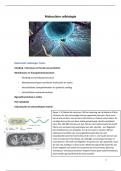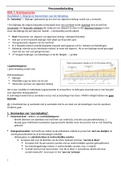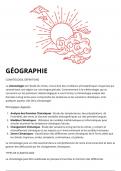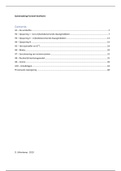confidence interval of the mean response for all members of the population when using the same
predicting values. true
See 1.7 Regression Line: Estimation & Prediction Examples
"Just to wrap up the comparison, the confidence intervals under estimation are narrower than the
prediction intervals becausethe prediction intervals have additional variance from the variation of
a new measurement."
In ANOVA, the linearity assumption is assessed using a plot of the response against the
predicting variable. false
See 2.2. Estimation Method
Linearity is not an assumption of ANOVA.
If the model assumptions hold, then the estimator for the variance, σ ^ 2, is a random variable.
true
See 1.8 Statistical Inference
We assume that the error terms are independent random variables. Therefore, the residuals are
independent random variables. Since σ ^ 2 is a combination of the residuals, it is also a random
variable.
The mean sum of squared errors in ANOVA measures variability within groups. true
See 2.4 Test for Equal Means
MSE = within-group variability
The simple linear regression coefficient, β ^ 0, is used to measure the linear relationship between
the predicting and response variables. false
See 1.2 Estimation Method
β ^ 0 is the intercept and does not tell us about the relationship between the predicting and
response variables.
The sampling distribution for the variance estimator in simple linear regression is χ 2 (chi-
squared) regardless of the assumptions of the data. false
See 1.2 Estimation Method
"The sampling distribution of the estimator of the variance is chi-squared, with n - 2 degrees of
freedom (more on this in a moment). This is under the assumption of normality of the error
terms."
β ^ 1 is an unbiased estimator for β 0. False
See 1.4 Statistical Inference
"What that means is that β ^ 1 is an unbiased estimator for β 1." It is not an unbiased estimator
for β 0.
If the pairwise comparison interval between groups in an ANOVA model includes zero, we
conclude that the two means are plausibly equal. true
See 2.8 Data Example
,If the comparison interval includes zero, then the two means are not statistically significantly
different, and are thus, plausibly equal.
Under the normality assumption, the estimator for β 1 is a linear combination of normally
distributed random variables. true
See 1.4 Statistical Inference
"Under the normality assumption, β 1 is thus a linear combination of normally distributed
random variables... β ^ 0 is also linear combination of random variables"
An ANOVA model with a single qualitative predicting variable containing k groups will have k +
1 parameters to estimate. true
See 2.2 Estimation Method
We have to estimate the means of the k groups and the pooled variance estimator, s p o o l e d 2.
In simple linear regression models, we lose three degrees of freedom when estimating the
variance because of the estimation of the three model parameters β 0 , β 1 , σ 2. false
See 1.2 Estimation Method
"The estimator for σ 2 is σ ^ 2, and is the sum of the squared residuals, divided by n - 2."
The pooled variance estimator, s p o o l e d 2, in ANOVA is synonymous with the variance
estimator, σ ^ 2, in simple linear regression because they both use mean squared error (MSE) for
their calculations. true
See 1.2 Estimation Method for simple linear regression
See 2.2 Estimation Method for ANOVA
The pooled variance estimator is, in fact, the variance estimator.
The normality assumption states that the response variable is normally distributed.false
See 1.8 Diagnostics
"Normality assumption: the error terms are normally distributed."
The response may or may not be normally distributed, but the error terms are assumed to be
normally distributed.
If the constant variance assumption in ANOVA does not hold, the inference on the equality of the
means will not be reliable. true
See 2.8 Data Example
"This is important since without a good fit, we cannot rely on the statistical inference."
Only when the model is a good fit, i.e. all model assumptions hold, can we rely on the statistical
inference.
A negative value of β 1 is consistent with an inverse relationship between the predictor variable
and the response variable. true
See 1.2 Estimation Method
"A negative value of β 1 is consistent with an inverse relationship"
The p-value is a measure of the probability of rejecting the null hypothesis. false
See 1.5 Statistical Inference Data Example
,"p-value is a measure of how rejectable the null hypothesis is... It's not the probability of
rejecting the null hypothesis, nor is it the probability that the null hypothesis is true."
We assess the constant variance assumption by plotting the error terms, ϵ i, against fitted values.
false
See 1.2 Estimation Method
"We use ϵ ^ i as proxies for the deviances or the error terms. We don't have the deviances
because we don't have β 0 and β 1.
With the Box-Cox transformation, when λ = 0 we do not transform the response. false
See 1.8 Diagnostics
When λ = 0, we transform using the normal log.
The sampling distribution of β ^ 0 is a
t-distribution
chi-squared distribution
normal distribution
None of the above t-distribution
See 1.4 Statistical Inference
The distribution of β 0 is normal. Since we are using a sample and not the full population, the
sampling distribution of β ^ 0 is the t-distribution.
A data point far from the mean of the x's and y's is always:
an influential point and an outlier
a leverage point but not an outlier
an outlier and a leverage point
an outlier but not a leverage point
None of the above None of the above
See 1.9 Outliers and Model Evaluation
We only know that the data point is far from the mean of x's and y's. It only fits the definition of
a leverage point because the only information we know is that it is far from the mean of the x's.
So you can eliminate the answers that do not include a leverage point. That leaves us with
remaining possibilities, "a leverage point but not an outlier" and "an outlier and a leverage point"
, both of which we can eliminate. We do not have enough information to know if it is or is not an
outlier . None of the answers above fit the criteria of it being always being a leverage point.
The following output was captured from the summary output of a simple linear regression model
that relates the duration of an eruption with the waiting time since the previous eruption.
Coefficients:
Estimate Std. Error t value Pr(>|t|)
(Intercept) -1.374016 A -1.70 0.045141 *
waiting 0.043714 0.011098 B 0.000052 ***
---
Signif. codes: 0 '***' 0.001 '**' 0.01 '*' 0.05 '.' 0.1 ' ' 1
, Residual standard error: 0.4965 on 270 degrees of freedom
Multiple R-squared: 0.8115, Adjusted R-squared: 0.8108
F-statistic: 1162 on 1 and 270 DF, p-value: < 2.2e-16
Using the table above, what is the standard error of the intercept, labeled A, and rounded to three
decimal places?
2.336
0.808
0.806
-0.806
None of the above 0.808
See 1.4 Statistical Inference
Std.Err = Estimate /t-value = -1.374016/-1.70 = 0.808
The following output was captured from the summary output of a simple linear regression model
that relates the duration of an eruption with the waiting time since the previous eruption.
Coefficients:
Estimate Std. Error t value Pr(>|t|)
(Intercept) -1.374016 A -1.70 0.045141 *
waiting 0.043714 0.011098 B 0.000052 ***
---
Signif. codes: 0 '***' 0.001 '**' 0.01 '*' 0.05 '.' 0.1 ' ' 1
Residual standard error: 0.4965 on 270 degrees of freedom
Multiple R-squared: 0.8115, Adjusted R-squared: 0.8108
F-statistic: 1162 on 1 and 270 DF, p-value: < 2.2e-16
Using the table above, what is the t-value of the coefficient for waiting, labeled B, and rounded
to three decimal places?
3.939
3.931
3.935
None of the above 3.939
See 1.4 Statistical Inference
t-value = Estimate /Std.Err= 0.043714/0.011098 = 3.939
The alternative hypothesis of ANOVA can be stated as,
the means of all pairs of groups are different
the means of all groups are equal
the means of at least one pair of groups is different











